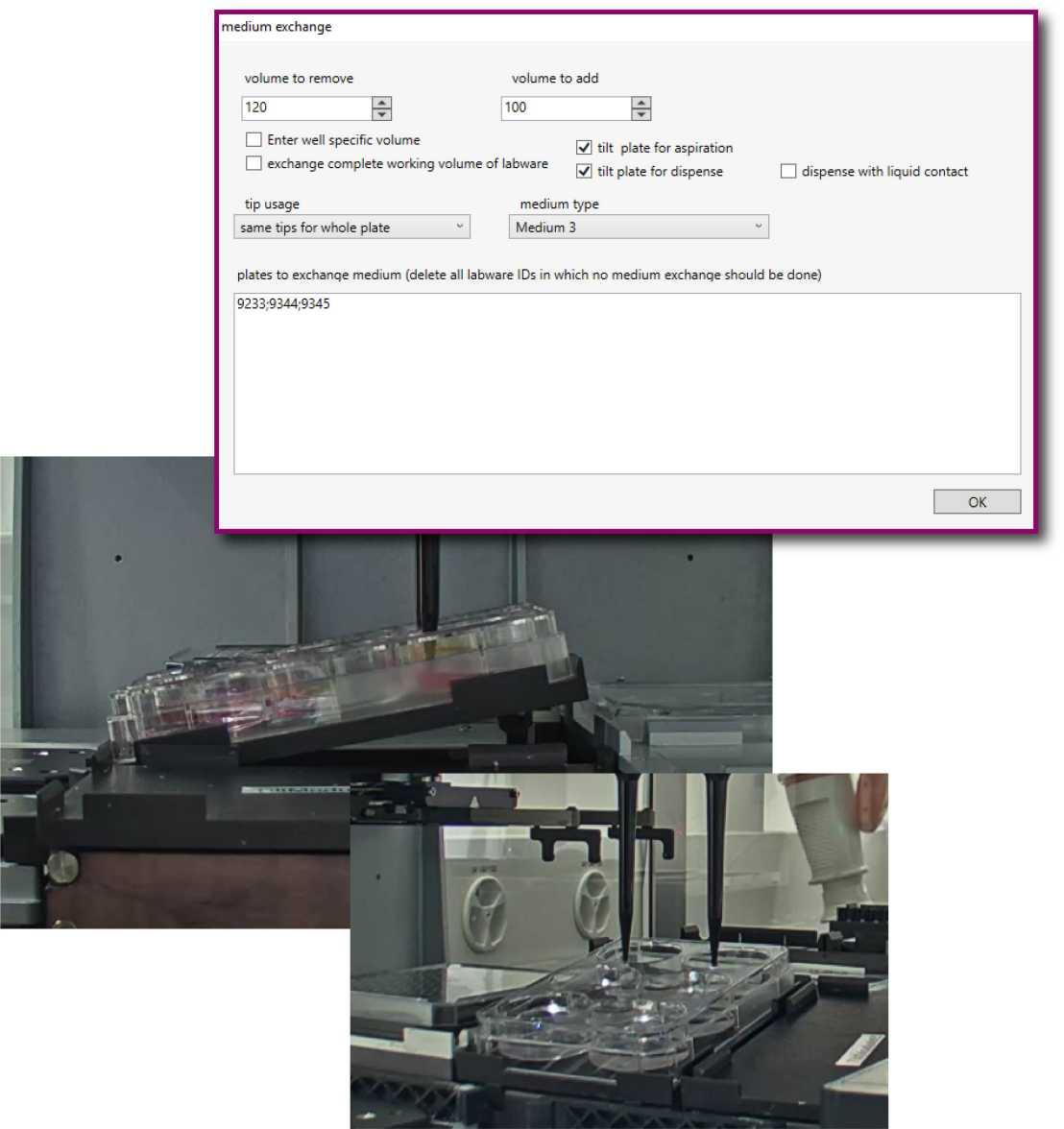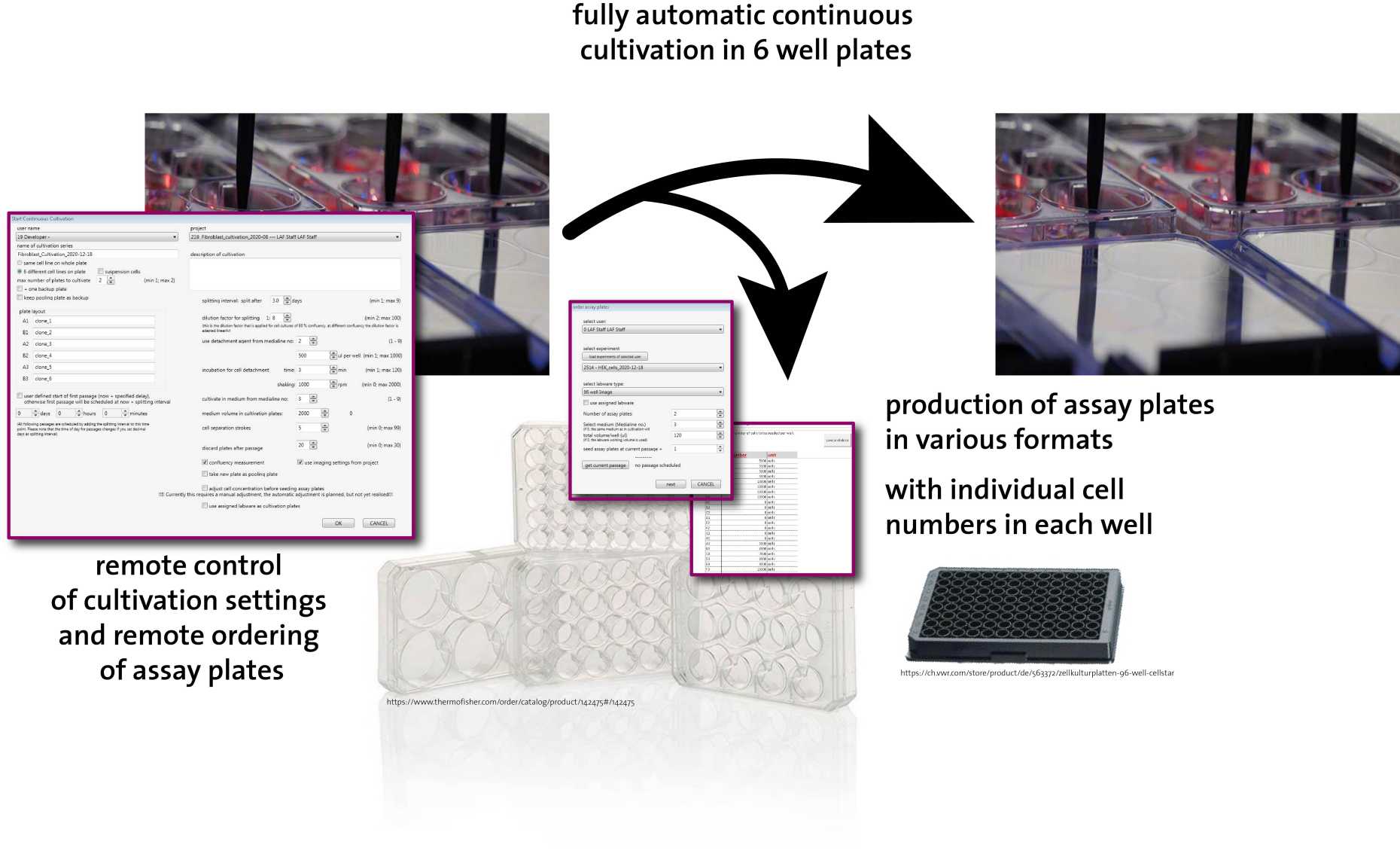Cell culture

Two robotic systems, each coupled to an automated incubator and a plate imager, are dedicated to cell culture-based experiments under sterile conditions running 24/7. The systems are used for to the automated production of microplate cultures of various mammalian cell lines, which can be further used, e.g. for automated transfection or compound screenings coupled to image-based or other phenotypical analyses.
Mammalian cell cultivation
On the mammalian cell culture platform (H0) adherent or suspension cells can be continuously and automatically cultivated. Growth of the cultures is monitored by an integrated imaging system and cells are passaged automatically in pre-defined intervals. The cell culture robotic system can be remote controlled, enabelling our users to handle their cell cultures from outside the laboratory. The users are informed regularly about the status of their cell cultures via email or SMS. In each cell culture experiment up to six different cell lines can be cultivated in 6-well plates.
Assay plate delivery
At each passage on the mammalian cell culture platform (H0), the user can order assay plates in a variety of different plate formats (6-well up to 96-well) from all cell lines in the experiment. The layout of the assay plates and the cell numbers to be seeded in each well can be defined individually by the user.
Production of cell suspension
At each passage on the mammalian cell culture platform (H0), the robot can provide cell suspension on demand. The user is informed via email or SMS to pick up the cells for manual downstream processing.
Medium exchange

If a medium exchange between passages is necessary, the supernatant on all cell culture plate formats can be exchanged on both of our cell culture systems (H0 and H1). This may be necessary to investigate cell growth in different media, to treat cells with drugs or to prepare assay plates for imaging, transfection or other cell based experiments. The volumes of medium to be removed and added, as well as the type of media to be used can be selected for each individual well of the plate. The medium exchange task can be scheduled to run at any desired time-point, allowing to condition assay plates during night time for early morning experiments.
Absorbance, fluorescence and luminescence as well as image-based readout
The cell culture robot (H0) is equipped with an imaging device (Celigo) and can run pre-scheduled imaging tasks automatically 24/7. The second cell culture robot (H1) is equipped with a Tecan M200 plate reader to perform time-lapse absorbance, fluorescence or luminescence measurments of mammalian cell cultures.
Dose-response pipetting
Two-fold serial dilution curves of up to 96 individual compounds can be prepared in 96-well plates on robot H1. Each dilution curve spans a concentration range of 1:1024 and includes a positive growth control without compound. The dilution curves can then be applied to assay plates using the media exchange method (see above). The assay plates for such experiments can be produced by the assay plate delivery method on the cell culture system H0 (see above). The response of the cells can be read out using the integrated Tecan plate reader (on H1) or the imager (on H0).
Transfection
The automated transfection method running on the cell culture system (H1) is currently overhauled to offer more flexibility and robustness. The scope of this method is to transfect mammalian cell cultures in 96-well plates using specific combinations of plasmids. The method supports use of Lipofectamin or PEI as transfection reagents. The transfection task can either be started manually or scheduled to be executed at pre-defined time. This allows our users to transfect cells during the night and have them ready for further treatment or readout the next morning.
Customized assays
If you plan large campaigns or if you have regular cell culture task to be done please do not hesitate to talk with us about automation possibilities. We are happy to expand the features of our cell culture systems (H0 and H1), to adapts methods to your needs or to program stand-alone methods to meet your requirements.

